2015 Peugeot 208 remove seats
[x] Cancel search: remove seatsPage 33 of 341
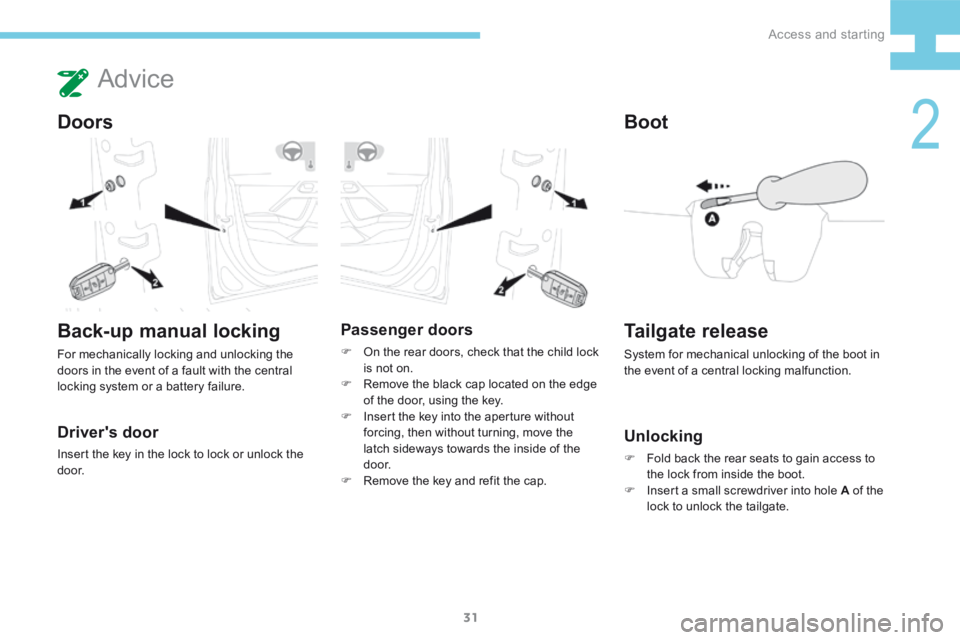
31
208_en_Chap02_ Acces-Demarrage_ed01-2015
Advice
Doors
Driver's door
Insert the key in the lock to lock or unlock the
d o o r.
Tailgate release
System for mechanical unlocking of the boot in
the event of a central locking malfunction.
Unlocking
F Fold back the rear seats to gain access to
the lock from inside the boot.
F Insert a small screwdriver into hole A of the
lock to unlock the tailgate.
Back-up manual locking
For mechanically locking and unlocking the
doors in the event of a fault with the central
locking system or a battery failure.
Passenger doors
F On the rear doors, check that the child lock
is not on.
F Remove the black cap located on the edge
of the door, using the key.
F Insert the key into the aperture without
forcing, then without turning, move the
latch sideways towards the inside of the
d o o r.
F Remove the key and refit the cap.
Boot
2
Access and starting
Page 69 of 341
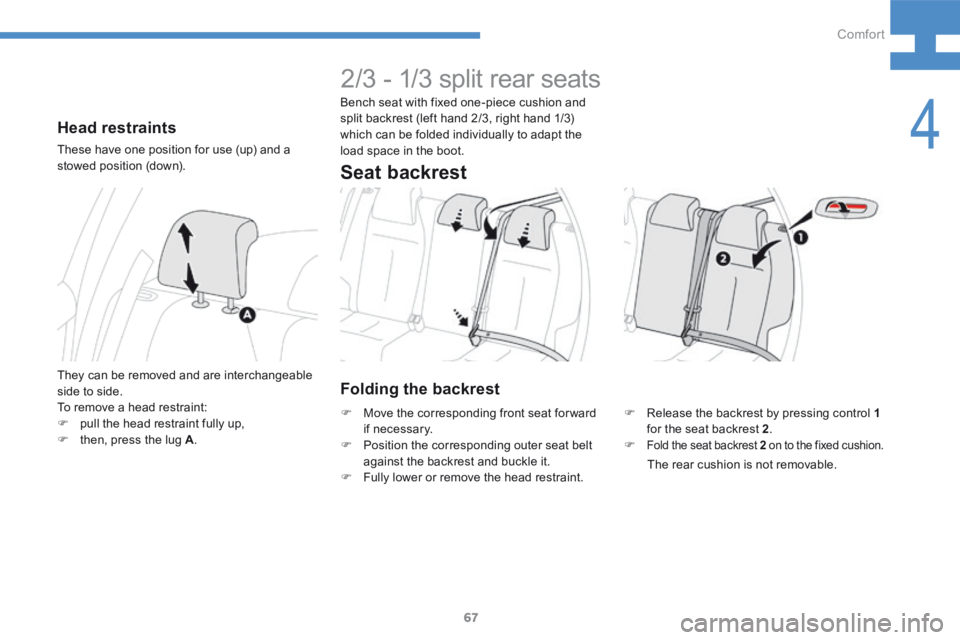
67
208_en_Chap04_confort_ed01-2015
Head restraints
These have one position for use (up) and a
stowed position (down).
They can be removed and are interchangeable
side to side.
To remove a head restraint:
F pull the head restraint fully up,
F then, press the lug A .
2/3 - 1/3 split rear seats
Folding the backrest
F Release the backrest by pressing control 1
for the seat backrest 2 .
F
Fold the seat backrest 2 on to the fixed cushion.
Bench seat with fixed one-piece cushion and
split backrest (left hand 2/3, right hand 1/3)
which can be folded individually to adapt the
load space in the boot.
F Move the corresponding front seat for ward
if necessary.
F Position the corresponding outer seat belt
against the backrest and buckle it.
F Fully lower or remove the head restraint. The rear cushion is not removable.
Seat backrest
4
Comfort
Page 94 of 341
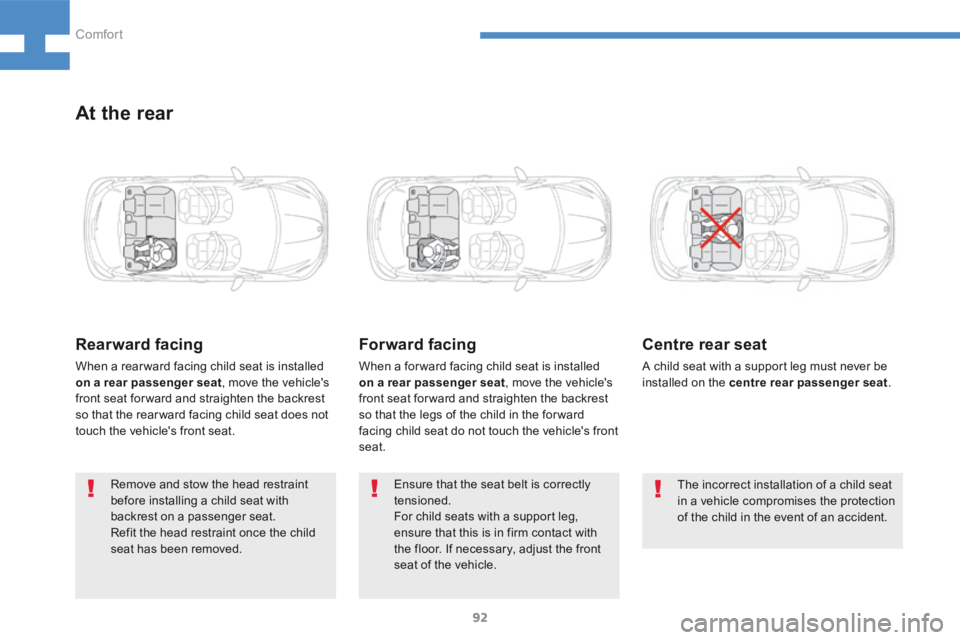
92
208_en_Chap04_confort_ed01-2015
At the rear
Rearward facing
When a rear ward facing child seat is installed
on a rear passenger seat, move the vehicle's
front seat for ward and straighten the backrest
so that the rear ward facing child seat does not
touch the vehicle's front seat.
Forward facing
When a for ward facing child seat is installed
on a rear passenger seat , move the vehicle's
front seat for ward and straighten the backrest
so that the legs of the child in the for ward
facing child seat do not touch the vehicle's front
seat.
Ensure that the seat belt is correctly
tensioned.
For child seats with a support leg,
ensure that this is in firm contact with
the floor. If necessary, adjust the front
seat of the vehicle.
Remove and stow the head restraint
before installing a child seat with
backrest on a passenger seat.
Refit the head restraint once the child
seat has been removed.
Centre rear seat
A child seat with a support leg must never be
installed on the centre rear passenger seat
.
The incorrect installation of a child seat
in a vehicle compromises the protection
of the child in the event of an accident.
Comfort
Page 98 of 341
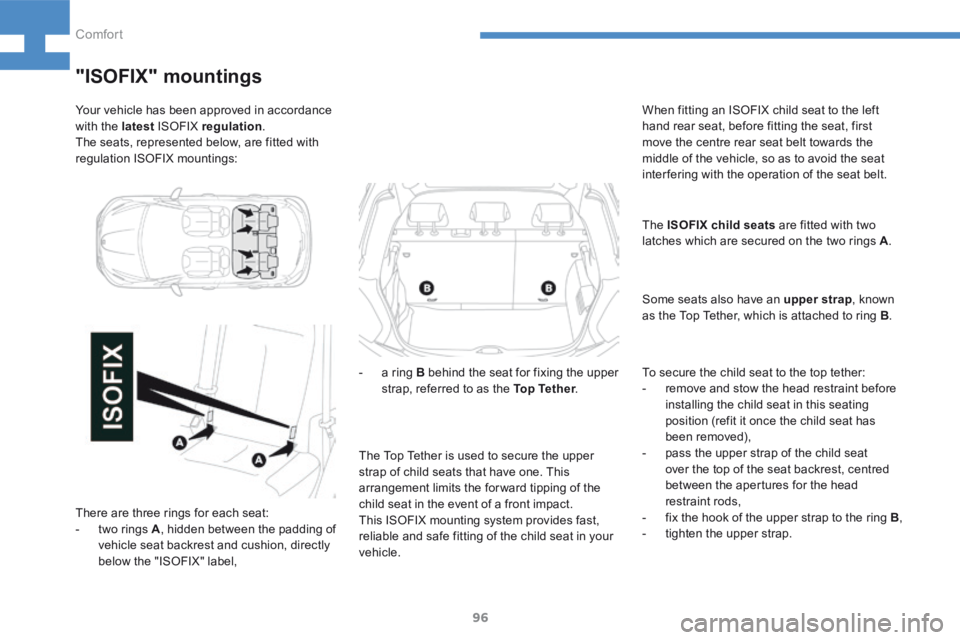
96
208_en_Chap04_confort_ed01-2015
Your vehicle has been approved in accordance
with the latest ISOFIX regulation .
The seats, represented below, are fitted with
regulation ISOFIX mountings:
"ISOFIX" mountings
There are three rings for each seat:
- two rings A , hidden between the padding of
vehicle seat backrest and cushion, directly
below the "ISOFIX" label, The Top Tether is used to secure the upper
strap of child seats that have one. This
arrangement limits the forward tipping of the
child seat in the event of a front impact.
This ISOFIX mounting system provides fast,
reliable and safe fitting of the child seat in your
vehicle. -
a ring B behind the seat for fixing the upper
strap, referred to as the Top Tether .When fitting an ISOFIX child seat to the left
hand rear seat, before fitting the seat, first
move the centre rear seat belt towards the
middle of the vehicle, so as to avoid the seat
interfering with the operation of the seat belt.
The ISOFIX child seats are fitted with two
latches which are secured on the two rings A
.
Some seats also have an upper strap , known
as the Top Tether, which is attached to ring B .
To secure the child seat to the top tether:
- remove and stow the head restraint before
installing the child seat in this seating
position (refit it once the child seat has
been removed),
- pass the upper strap of the child seat
over the top of the seat backrest, centred
between the apertures for the head
restraint rods,
- fix the hook of the upper strap to the ring B ,
- tighten the upper strap.
Comfort
Page 101 of 341
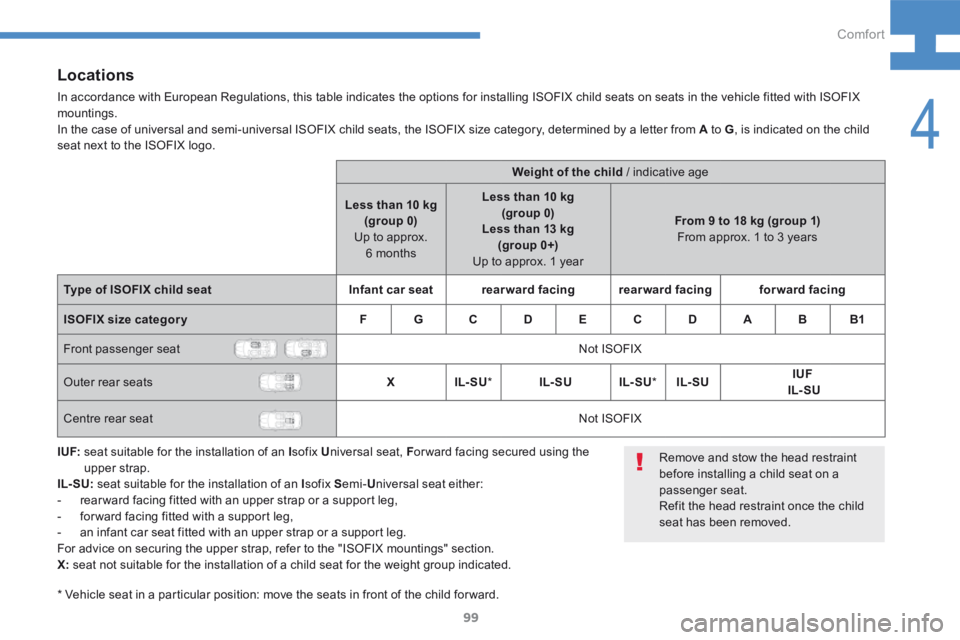
99
208_en_Chap04_confort_ed01-2015
Locations
In accordance with European Regulations, this table indicates the options for installing ISOFIX child seats on seats in the vehicle fitted with ISOFIX
mountings.
In the case of universal and semi-universal ISOFIX child seats, the ISOFIX size category, determined by a letter from A to G, is indicated on the child
seat next to the ISOFIX logo.
Weight of the child / indicative age
Less than 10 kg (group 0)
Up to approx. 6 months Less than 10 kg
(group 0)
Less than 13 kg (group 0+)
Up to approx. 1 year From 9 to 18 kg (group 1)
From approx. 1 to 3 years
Type of ISOFIX child seat Infant car seatrearward facing rearward facing forward facing
ISOFIX size categor y FG CD EC DABB1
Front passenger seat Not ISOFIX
Outer rear seats XIL- SU* IL- SU IL- SU*IL- SU IUF
IL- SU
Centre rear seat Not ISOFIX
I UF: seat suitable for the installation of an I sofix Universal seat, F or ward facing secured using the
upper strap.
IL- SU: seat suitable for the installation of an I sofix Semi-Universal seat either:
- rear ward facing fitted with an upper strap or a support leg,
- for ward facing fitted with a support leg,
- an infant car seat fitted with an upper strap or a support leg.
For advice on securing the upper strap, refer to the "ISOFIX mountings" section.
X: seat not suitable for the installation of a child seat for the weight group indicated.
* Vehicle seat in a particular position: move the seats in front of the child for ward. Remove and stow the head restraint
before installing a child seat on a
passenger seat.
Refit the head restraint once the child
seat has been removed.
4
Comfort
Page 110 of 341
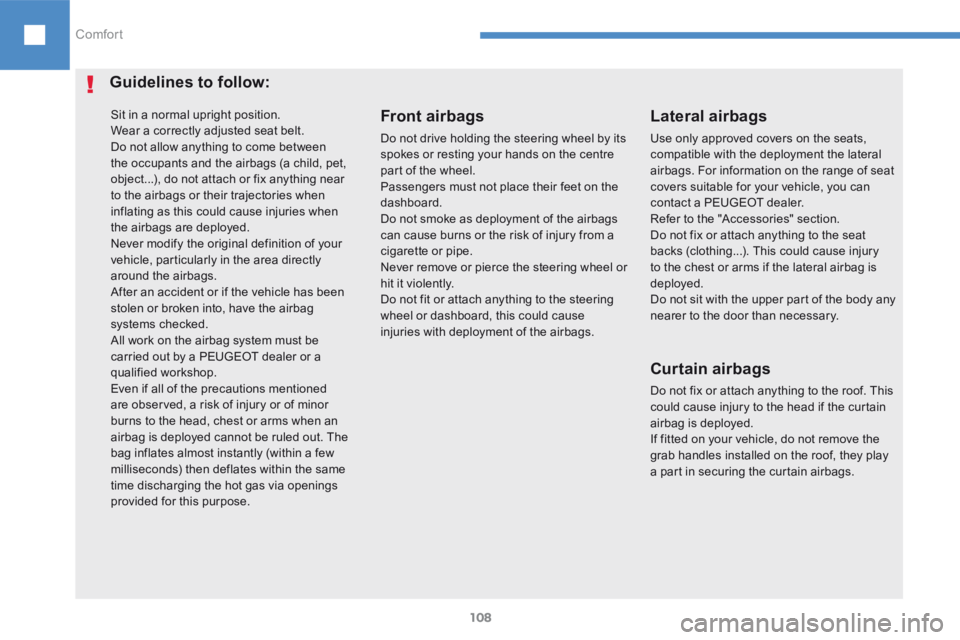
108
208_en_Chap04_confort_ed01-2015
Sit in a normal upright position.
Wear a correctly adjusted seat belt.
Do not allow anything to come between
the occupants and the airbags (a child, pet,
object...), do not attach or fix anything near
to the airbags or their trajectories when
inflating as this could cause injuries when
the airbags are deployed.
Never modify the original definition of your
vehicle, particularly in the area directly
around the airbags.
After an accident or if the vehicle has been
stolen or broken into, have the airbag
systems checked.
All work on the airbag system must be
carried out by a PEUGEOT dealer or a
qualified workshop.
Even if all of the precautions mentioned
are observed, a risk of injury or of minor
burns to the head, chest or arms when an
airbag is deployed cannot be ruled out. The
bag inflates almost instantly (within a few
milliseconds) then deflates within the same
time discharging the hot gas via openings
provided for this purpose.Lateral airbags
Use only approved covers on the seats,
compatible with the deployment the lateral
airbags. For information on the range of seat
covers suitable for your vehicle, you can
contact a PEUGEOT dealer.
Refer to the "Accessories" section.
Do not fix or attach anything to the seat
backs (clothing...). This could cause injury
to the chest or arms if the lateral airbag is
deployed.
Do not sit with the upper part of the body any
nearer to the door than necessary.
Front airbags
Do not drive holding the steering wheel by its
spokes or resting your hands on the centre
part of the wheel.
Passengers must not place their feet on the
dashboard.
Do not smoke as deployment of the airbags
can cause burns or the risk of injury from a
cigarette or pipe.
Never remove or pierce the steering wheel or
hit it violently.
Do not fit or attach anything to the steering
wheel or dashboard, this could cause
injuries with deployment of the airbags.
Guidelines to follow:Curtain airbags
Do not fix or attach anything to the roof. This
could cause injury to the head if the curtain
airbag is deployed.
If fitted on your vehicle, do not remove the
grab handles installed on the roof, they play
a part in securing the curtain airbags.
Comfort
Page 145 of 341
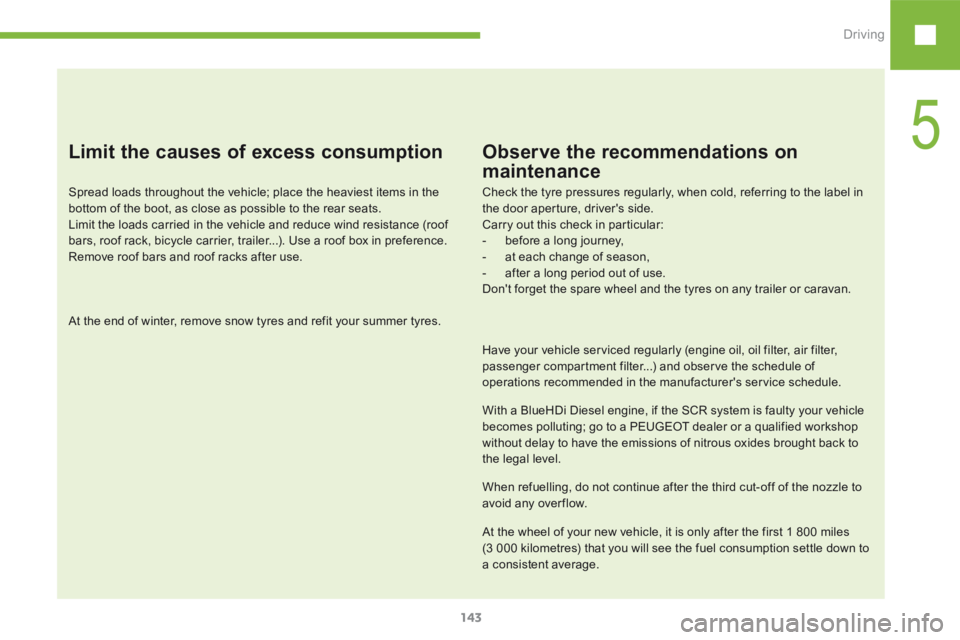
143
208_en_Chap05_conduite_ed01-2015
Limit the causes of excess consumption
Spread loads throughout the vehicle; place the heaviest items in the
bottom of the boot, as close as possible to the rear seats.
Limit the loads carried in the vehicle and reduce wind resistance (roof
bars, roof rack, bicycle carrier, trailer...). Use a roof box in preference.
Remove roof bars and roof racks after use.
At the end of winter, remove snow tyres and refit your summer tyres.
Observe the recommendations on
maintenance
Check the tyre pressures regularly, when cold, referring to the label in
the door aperture, driver's side.
Carry out this check in particular:
- before a long journey,
- at each change of season,
- after a long period out of use.
Don't forget the spare wheel and the tyres on any trailer or caravan.
Have your vehicle serviced regularly (engine oil, oil filter, air filter,
passenger compartment filter...) and observe the schedule of
operations recommended in the manufacturer's service schedule.
With a BlueHDi Diesel engine, if the SCR system is faulty your vehicle
becomes polluting; go to a PEUGEOT dealer or a qualified workshop
without delay to have the emissions of nitrous oxides brought back to
the legal level.
When refuelling, do not continue after the third cut-off of the nozzle to
avoid any over flow.
At the wheel of your new vehicle, it is only after the first 1 800 miles
(3 000 kilometres) that you will see the fuel consumption settle down to
a consistent average.
5
Driving
Page 166 of 341
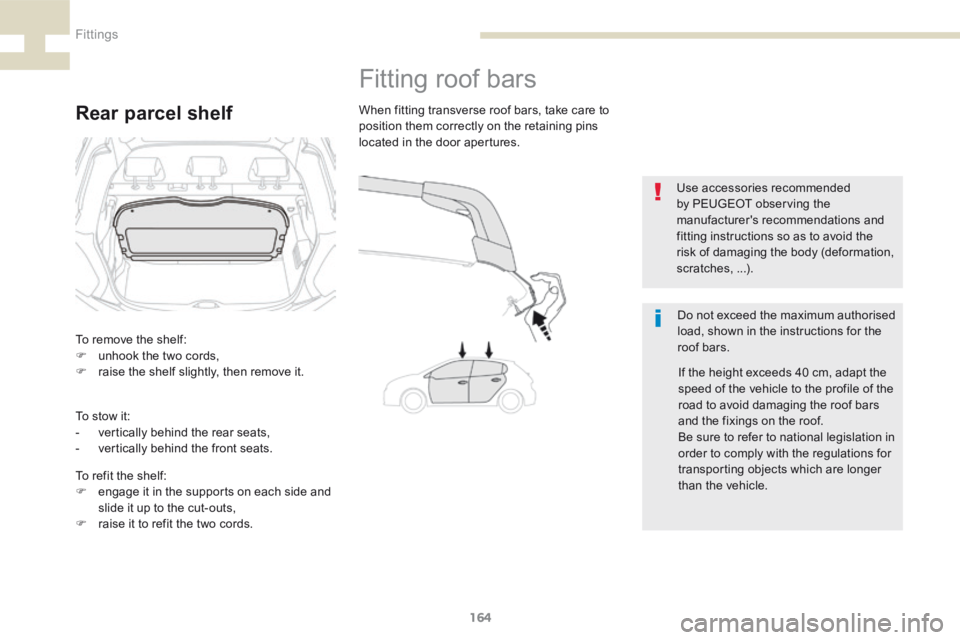
164
208_en_Chap07_ Amenagements_ed01-2015
Rear parcel shelf
Fitting roof bars
Do not exceed the maximum authorised
load, shown in the instructions for the
roof bars.
When fitting transverse roof bars, take care to
position them correctly on the retaining pins
located in the door apertures.
Use accessories recommended
by PEUGEOT observing the
manufacturer's recommendations and
fitting instructions so as to avoid the
risk of damaging the body (deformation,
scratches, ...).
If the height exceeds 40 cm, adapt the
speed of the vehicle to the profile of the
road to avoid damaging the roof bars
and the fixings on the roof.
Be sure to refer to national legislation in
order to comply with the regulations for
transporting objects which are longer
than the vehicle.
To remove the shelf:
F
unhook the two cords,
F raise the shelf slightly, then remove it.
To refit the shelf:
F engage it in the supports on each side and
slide it up to the cut-outs,
F raise it to refit the two cords.
To stow it:
-
vertically behind the rear seats,
- vertically behind the front seats.
Fittings